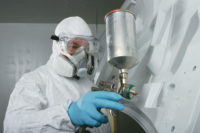"It took several minutes after ending the phone call for me to really get a grip on what was just discussed. Ralph Lewis, one of best guys on the plant floor, had suffered severe injuries from a fall off some equipment yesterday around 2:30. Early reports from the hospital indicate that he will live, but it will be the life of a totally disabled person.
"In addition to the personal sadness - Ralph is one of the really nice people working here - I have to resolve the huge problems that are the fallout (no pun intended) of this incident. It really doesn't make sense. Ralph and five or six other guys are up on that equipment every month; sometimes every week and no one ever fell off - until now. We've had a couple of close calls, but never any falls.
"First problem to solve is the loss of a key person. We'll have to shuffle some responsibilities and I know that we will lose a large amount of time and money because we won't have Ralph's experience and skills anymore. We need to get another qualified person hired and that won't be easy. Second, I will need to get an estimate of what this will do to our workers' comp insurance costs. Last year's seminar on comp costs had some examples. This fall could cost us hundreds of thousands. I'll have to explain this to the boss and figure out what we'll have to cut to make up for it. Looks like my bonus is down the drain this year."
There is one more thing to be done, right away. (It should have done before, but that's all water over the dam.) This location needs to find out what other fall protection problems it has and get them fixed ASAP. Maybe this was the only one. But most plants are loaded with fall hazards with the potential for serious injuries or worse. So let's look at seven simple steps needed to protect workers.
1) Survey your site
Get someone who knows the ins and outs of fall protection to come to your plant and walk the whole place. Make sure they've been to lots of different companies because they will see stuff that your own folks are too accustomed to in order to see the risks. These specialists have the technical training and experience you need. Make sure the survey includes all of the odd plant maintenance jobs and even jobs where employees are doing normal tasks at heights.2) Write an assessment report
The person doing the survey will write a report, probably with some digital photos and maybe even some videotape of locations and situations where his experience indicates potential falls from heights. These could be from the top of machines to ladders to mezzanine openings. Let the report give you the specifics. Top-notch firms use digital photos and video to get evaluations by their colleagues and even by equipment suppliers. It can be like having a half-dozen experts come to your site, but you only have to pay for the travel time of one.3) List options
Get the person who writes the report to give you some basic options on how to solve each of the identified fall hazard problems. Sometimes you'll get lucky with ideas to eliminate the risks entirely. Example: A building with two unprotected exterior ladders, each just over 40 feet high. Discussion with the workers who use the ladder and their supervisor indicate that they could do their work without problems using only one ladder. So one ladder gets removed and the other ladder gets some fall protection added to it.4) Rank your risks
If you have more than one fall protection problem, get a risk rating for each one and then rank the problems accordingly. The idea is to solve the most serious potential problem first, although you should plan to solve all of them as quickly as you can. Risk ratings take into account issues such as frequency, severity, environment, etc.5) Obtain proposals
You will need some solid proposals on how to resolve (that means solve) these hazards. Some ideas might mean changing methods such as using a man lift instead of having an employee hang by his legs from some odd pipe to change valve settings with his hands.
Proposals should be approximate costs of getting solutions, and there might be several reasonable solutions to just one problem. There are some very good new technical solutions developed in the past few years. These ideas need review regarding their effect on your operations before you go further. There might be a need for some structural engineering work to make sure that your building(s) and the fall protection are in harmony.
6) Get quotes
After you select the best solution for each problem, get quotes or proposals on supplying and installing structural safeguards, oufitting employees with any personal fall protection gear, and training costs. You will probably need to get some money authorized, and that will take some estimate of the potential costs if you do not solve the problem. (Just tell them what Ralph's fall did to the comp insurance costs.)7) Install the solution
Get it done. Make sure that the training provided is what you really need. There also can be the need for some periodic maintenance checks and equipment re-certifications. Qualified suppliers know the needs. Make sure the proposed program is followed, perhaps using the supplier to help you verify this.So where do you find the people to do these seven steps? You can hire consultants to cover steps one through four. There are qualified safety equipment distributors who can do five and six, and there are certified equipment installers to do step seven. A few companies out there actually do it all from start to finish, giving you a more complete result with responsibility placed squarely on one source.
